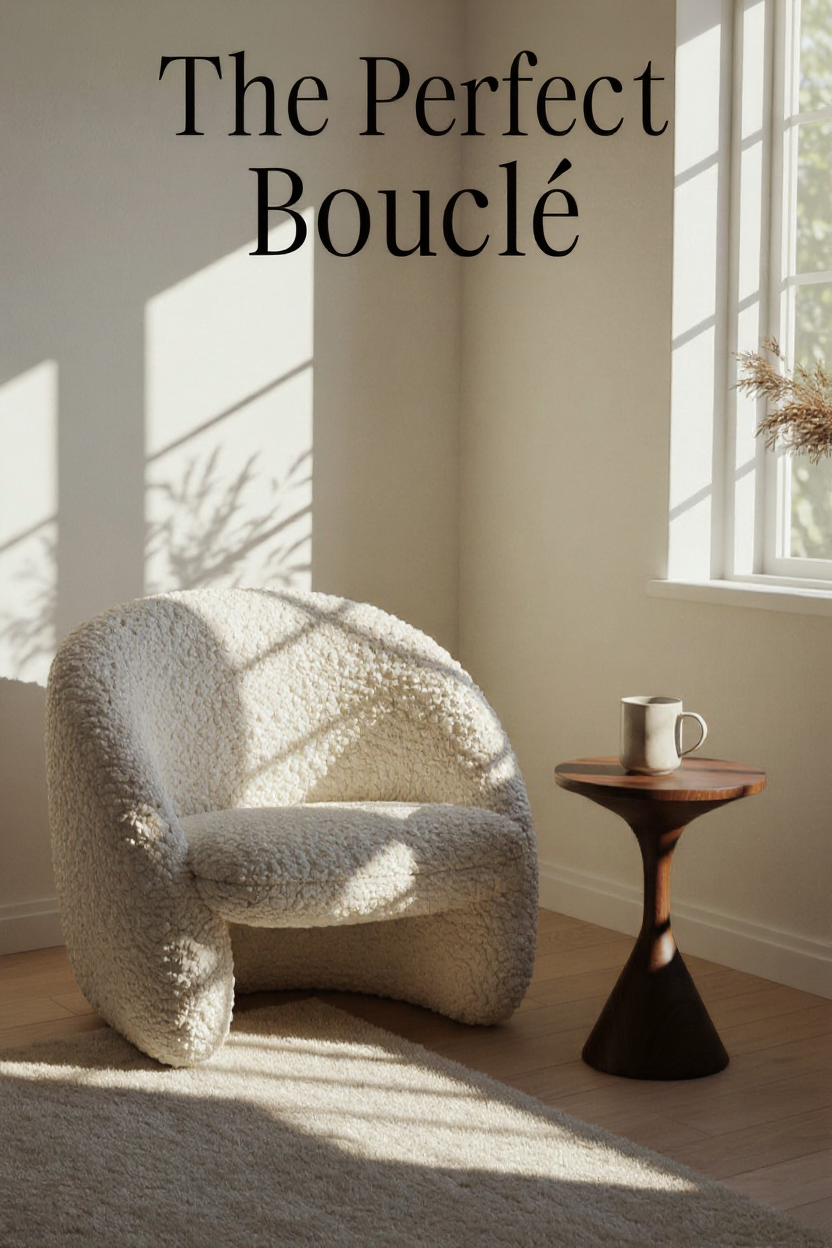Picture a quiet corner in a room, bathed in the soft morning light filtering through a nearby window. In this serene spot sits a generously curved armchair, upholstered in a soft, cream-colored bouclé fabric. Its inviting texture seems to absorb the sunlight, casting gentle shadows that highlight its rounded form. Next to it, a small, elegant wooden side table holds a simple mug, suggesting a peaceful moment of repose. This scene, captured in the first image, is the perfect entry point into one of today’s most beloved interior design trends: the artful use of texture to bring comfort and sophistication into our homes.
This approach is about more than just a single piece of furniture; it’s a philosophy that balances minimalism with a deep sense of coziness. Let’s explore how you can introduce this warm, tactile elegance into your own space.
The Beauty is in the Details
Take a closer look at the fabric itself. Bouclé, with its distinctive looped and nubby surface, is wonderfully tactile. As seen in a close-up, the way the fabric wraps around the soft curves of a chair’s arm demonstrates its appeal. When placed next to a contrasting material, like the smooth, rich grain of a dark wood table, the texture of the bouclé becomes even more pronounced. This interplay of surfaces adds visual depth and interest to a room without needing loud colors or busy patterns. It’s an understated detail that speaks volumes about quality and comfort.
Set the Mood with Thoughtful Lighting
The way light interacts with textured surfaces can completely transform a room’s atmosphere. Natural daylight, as we saw, is fantastic, but the right artificial lighting is just as important for evening ambiance. An elegant arc floor lamp, for instance, can be positioned to cast a warm, focused glow directly onto a bouclé chair. This not only makes for a perfect reading spot but also accentuates the fabric’s unique texture, turning the chair into a gentle, illuminated focal point in the evening. This focused lighting technique helps build a cozy, intimate environment.
Build a Foundation of Comfort
Texture shouldn’t be limited to just your seating. To achieve a truly cohesive and inviting space, think about layering textures from the ground up. Placing a bouclé or similarly textured armchair on a high-pile, plush shag rug is a wonderful example of this. The combination of the chair’s nubby weave and the rug’s soft, deep pile works together to amplify the sense of comfort. Even within a monochromatic color scheme of whites and creams, this layering of different textures provides richness and prevents the space from feeling flat or sterile.
Harmonize with Natural Elements
To balance the soft, neutral tones of textured fabrics, introducing natural elements is key. A tall, vibrant houseplant, like a fiddle-leaf fig, brings a touch of life and organic beauty to the room. Its glossy green leaves offer a refreshing contrast to the soft upholstery. This connection to nature enhances the overall feeling of tranquility. Draping a simple throw blanket over the arm of the chair adds another layer of texture and practicality, while a stack of books on a nearby side table suggests a space that is meant to be lived in and enjoyed.
Where Functionality Meets Form
This aesthetic of warm minimalism extends beyond just the cozy corner. It integrates seamlessly into the wider living area with pieces that are both stylish and highly functional. Consider a modern sofa with clean lines, upholstered in a durable, subtly textured fabric. Paired with a sleek, C-shaped side table, the look is both contemporary and practical. The table’s slim metal frame allows it to slide conveniently over the sofa’s arm, providing a surface for a drink or a book without taking up floor space. It’s a perfect example of how smart, minimalist design can support a comfortable, textured, and uncluttered lifestyle.
By focusing on these elements—rich textures, a neutral palette, natural materials, and smart, functional design—any home can be transformed into a haven of serene comfort and understated elegance.







